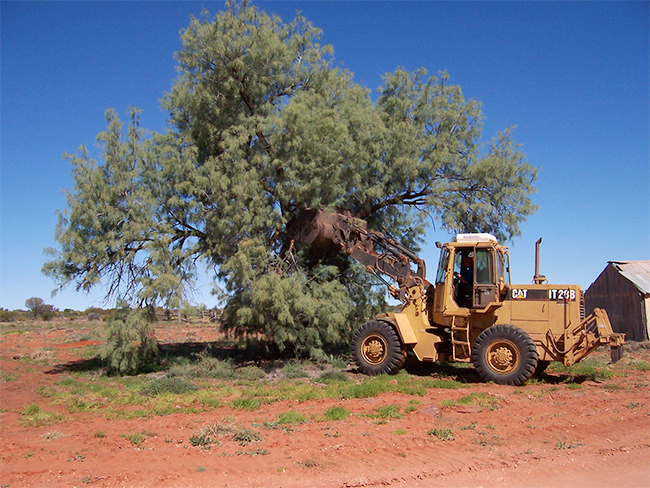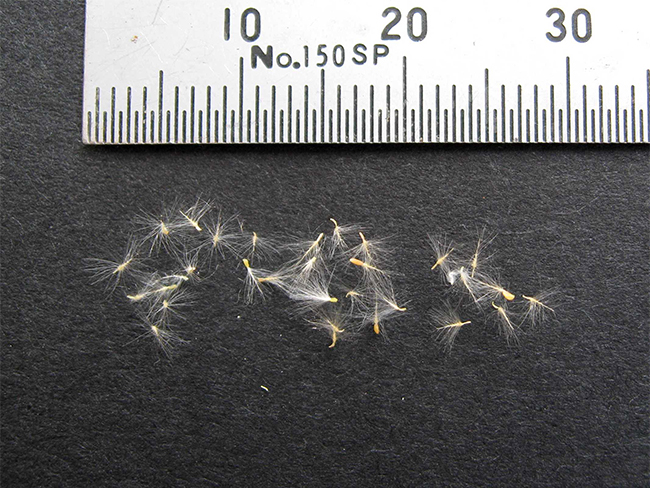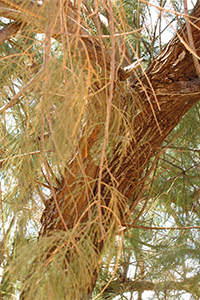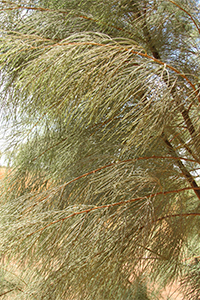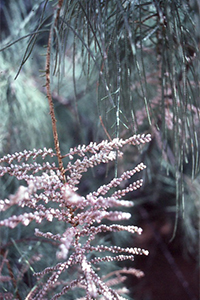Athel pine
Scientific name: Tamarix aphylla
Declaration status: Class A and Class B
Athel pine has a statutory weed management plan PDF (1.9 MB) which outlines the legal requirements for control.
You can also read a summary of the athel pine 2021 weed management plan review PDF (1.0 MB).
Athel pine is a Weed of National Significance. For more information, go to the Australian Government's Weeds of National Significance website.
Athel pine is native to northern Africa, the Arabian Peninsula, Iran and India.
It was introduced to Australia around 1930 from California as a shade tree.
The first plantings were at Whyalla and Broken Hill and it has since been planted extensively around New South Wales, Queensland, Western Australia and the Barkly Tableland and Alice Springs regions of the Northern Territory (NT).
In the NT athel pine has invaded the Finke River, the largest river system of Central Australia, and extends for 600km along this watercourse.
Impact
Athel pine can have all of the following impacts:
- form monocultures that rapidly displace native vegetation
- displace iconic river red gums and coolabah trees
- extract salt from the soil and causes salinisation up to 50m away
- only allow salt-tolerant herbs or grasses to grow
- reduce grazing areas
- not provide nectar or hollows for nesting native animals
- lower the water table
- dry up waterholes
- add to sedimentation
- change the course of rivers.
Identification
You should use this as a guide. There may be other plants or weeds that look similar.
- large, spreading tree up to 18m tall
- flowering plant with strong woody roots which penetrate soil and spread deeply
- trunk has rough, dark brown bark
- foliage looks like pine needles
- tiny leave attached to needles are 1mm to 2mm long
- pendulous and hanging branches
- flowers are tiny, white or pink and form in dense spiral clusters
- fruit are 3mm long bell-shaped capsules
- seeds are covered with a tuft of fine hairs.
To find out more, get the athel pine weed note on the Department of Lands, Planning and Environment website.
If you are unsure, contact the Weed Management Branch.
Similar looking plants
The following plant species look similar to athel pine:
Tamarisk ramosissima has invaded many arid land reserves in the United States and is also a potential invader of streams and marshes in Australia. It only grows to about half the size of athel pine.
Casuarinas or she-oaks are very similar in appearance to athel pine, however they have hard, woody fruit like mini pine cones and lack true flowers.
Control
Chemical control
Large, established athel pine trees are difficult to control. Large trees can be cut off at ground level followed by herbicide application to the stump. The tree should then be taken away from any drainage area and burnt.
| Chemical and concentration | Rate | Weed growth, stage and methods |
|---|---|---|
|
Fluroxypyr 333 g/L Starane® Advanced - plus other registered products | 600ml / 100L water | Foliar spray for seedlings less than 50cm tall |
|
Triclopyr 600 g/L Garlon® 600 - plus other registered products | 1L / 100L water 1L / 60L diesel | For juveniles 50cm to 2m in height:
|
These chemicals and rates are specified by APVMA permit PER81696 which allows minor use of an agvet chemical product to control seedlings athel pine in non-crop areas in and near dry ephemeral waterways. The permit expires on 30 November 2020.
Don't contaminate streams, rivers or waterways with the chemical or used container.
Withholding Period: Garlon 600 Herbicide (or equivalent): Not required when used as directed. Fluroxypyr products: Don't graze or cut for stock food for seven days after application.
Non-chemical control
Hand pulling and grubbing
Weeds, including their roots, are physically pulled out of the ground by hand or using hand tools.
This is an effective method of control for individual weeds and recent outbreaks that haven’t released seeds yet, but it requires a lot of labour.
Bulldozing
Bulldozers, chopper rollers or graders are used to clear large weed infestations. This leaves large areas of soil exposed so follow up control or revegetation should be considered.
Fire
Fire as a management technique is most effective when it is used together with other methods. It is useful for mass seedling control if there is a sufficient fuel load.
Spread
Athel pine seeds are distributed by wind, but a more common method of dispersal is for broken branches carried by flood water to produce new plants.
Spread prevention
You can prevent the spread of athel pine by doing all of the following:
- destroy all isolated athel pines including homestead and shade plantings (except where there is a valid permit to retain)
- map infestations to help develop a management plan
- control minor infestations, isolated outbreaks or seedlings first
- designate wash down areas and actively work to prevent contamination of clean areas
- monitor areas that you have treated and watch for re-infestations.
Give feedback about this page.
Share this page:
URL copied!
